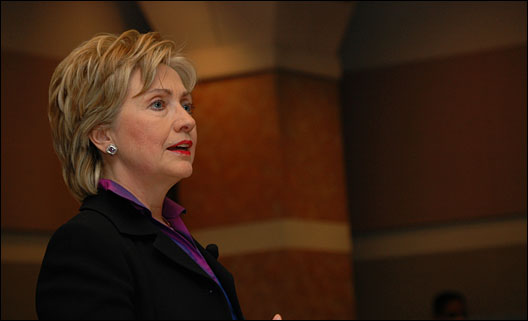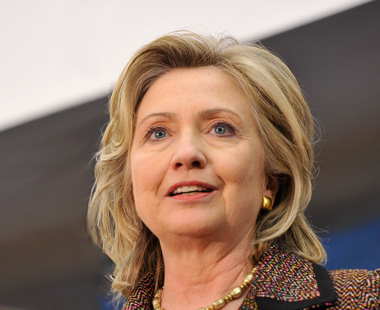
This is part of a series of interviews with presidential candidates produced jointly by Grist and Outside.
Update: Clinton suspended her campaign for the presidency on June 7, 2008.

True to form, New York Sen. Hillary Clinton has done her homework on environmental and energy issues. A member of the Environment and Public Works Committee during her six and a half years in the Senate, she has sponsored or cosponsored nearly 400 legislative proposals related to energy and the environment. They’ve hit on high-profile topics like energy independence as well as less-discussed green issues like toxic exposure, environmental justice, and brownfield redevelopment. While Clinton hasn’t been a trailblazer in the fight against climate change, she has been vocal on the need to pursue clean energy and protect the Arctic National Wildlife Refuge. Her efforts have earned a respectable grade from the League of Conservation Voters — a 90 percent lifetime voting score. [Update: In February 2008, Clinton’s lifetime LCV score was changed to 87 — lower than before because she missed some key votes while on the road campaigning.]
But many enviros aren’t convinced that Clinton is at the head of the class on green issues, noting that she supports “clean coal,” and, like nearly every other candidate, pounds the drum for corn ethanol. Can she win the green lobby to her side? To get a feel for her chances, I caught Clinton by phone after a picnic on the Iowa campaign circuit.
For more info on her platform and record, check out Grist’s Clinton fact sheet.
What makes you the strongest green candidate? What sets your energy and environmental platform apart?
I believe my proposals for energy and environmental priorities are really well thought-out and comprehensive. You know, I have been focusing on these issues for years. Obviously, I have been a child advocate for most of my adult life, and as first lady I focused on the environmental effects on children’s health. I have served, since I arrived in the Senate, on the Environment and Public Works Committee, and I am proud of the work that I’ve done to stand up against the Bush administration’s many efforts to weaken environmental laws.
I have worked to pass the Brownfields Revitalization Act and the Diesel Emissions Reduction Act. I’ve taken many actions specific to New York, like pushing for the Hudson River cleanup by GE. I have been very committed on health-related effects — that is why I’ve got legislation to try to deal with asthma and other respiratory diseases and to reduce pollution from power plants. Time and time again I have tried to protect public lands, including the Arctic National Wildlife Refuge in Alaska. I cosponsored the Roadless Area Conservation Act to try and get back what my husband had done as president to protect the National Forest system. I believe strongly in supporting the “polluter pays” principle, and I am going to work to try to reinstate that.
I have done a lot of other things that I care a lot about, but one final point I would mention is that early on in my Senate career I introduced bipartisan legislation to establish an environmental health tracking network, to better understand the impact of environmental hazards on human health and well-being. That was important when I began to tackle the toxic legacy of 9/11.
In the Senate, you have supported the goal of an 80 percent reduction in greenhouse gases by 2050. Is this a centerpiece of your platform?
It is. I joined with Sens. [Barbara] Boxer and [Bernie] Sanders because I thought that their bill was the most forward-leaning in terms of what needs to be done to deal with the threat of global warming, and I’m very proud to support their legislation.
And obviously I have my own proposals. I want to create a Strategic Energy Fund that would be funded by taking money away from the oil companies, by giving them the choice to invest in renewable energy or pay into the fund. We would take away their tax subsidies as well, and we would use this fund to create a clean-energy industry and millions of jobs in America.
How will the funds be distributed among alternative energy sources — for instance, will they be weighted toward coal, ethanol, solar, or wind?
My model is the Defense Advanced Research Projects Agency, which brought together the best minds in academia, business, and government. It incentivized researchers and entrepreneurs to tackle the space program and the Cold War military challenges, and [eventually] led to the invention of the internet.
What I want to do is not only look at existent, known forms of renewable energy and how we can move more quickly to commercial application and distribution for solar, wind, and geothermal, but also look at other forms of biofuel and biodiesel. You know, let’s take a look at the internal combustion engine. Let’s figure out if there are some new ideas out there that would play to America’s strengths as we move toward less of a dependence on foreign oil and more homegrown energy.
What role will coal play in your plan?
I think we have got to take a hard look at clean coal. I have advocated carbon sequestration, I have advocated power plants looking for ways to use coal more cleanly and efficiently. I doubt very much that using coal in liquid form for transportation could ever pass the environmental test, but I am willing to do the research to prove one way or another.
The political pressure [to use coal] will remain intense, and I think you have got to admit that coal — of which we have a great and abundant supply in America — is not going away. So how do we best manage the possibility of using clean coal, but having very strict environmental standards? It is not going to do us any good if we substitute one dirty energy source for another.
I am agnostic about nuclear. I am very skeptical that nuclear could become acceptable in most regions of the country, and I am doubtful that we have yet figured out how to deal with the waste. But I keep being given information about research that is being done to resolve the waste problem. I know that will continue because that has a lot of economic power and resources behind it. But until we can figure out what to do with the waste and overcome the political objections, we should not be putting a heavy emphasis on nuclear.
Do you believe we need a carbon tax in addition to a cap-and-trade system?
There is a lot of interest now in figuring out what the most efficient and effective means of controlling and decreasing greenhouse gases would be. I’m looking for what will work and produce results. A cap-and-trade [program] can be designed and implemented in a number of ways. I would strongly favor using an auction for the allocation of the permits — an auction that would [sell] as close to 100 percent of the permits as possible [rather than giving a percentage of them away for free]. But I think that there are a number of other serious proposals. I will entertain what I think are the best proposals that are politically viable. We still face tremendous opposition from the Republicans.
Whatever we do, we have to do it soon. We can’t keep talking about it. If we can’t get to the end point soon with a comprehensive proposal, then let’s make as much progress as possible while we have a Republican president who is beholden to the oil companies and who is uninterested in taking action.
Would you oppose subsidizing any technology that would worsen global warming, even if it would advance energy independence?
Absolutely. I believe that it has got to be two for the price of [one], it has got to be a win-win. We can’t make the [global-warming] problem worse. Now, obviously, you have to have waivers because of national-security implications — because if terrorists go after our oil supply, we are going to keep figuring out where to find oil, as we make a transition. It is always dangerous to say, “never” and “I will never do this.” But certainly, my goal would be to subsidize clean technologies just like we subsidized gas, oil, and coal for years.
How would you balance the call for higher fuel-economy standards with the call to help the U.S. auto industry? What fuel-economy targets would you support?
I believe we need to increase our fuel efficiency in order to reduce global warming. I have supported a fuel-efficiency standard of 35 miles per gallon by 2020, and I’ve supported a variety of proposals, including tax incentives and other approaches, to help ensure that the next generation of vehicles is much more efficient than the last.
Some people believe we should only commit to a global climate treaty if China and India do as well. Do you agree? How would you bring China and India to the table?
Global warming is a global problem that’s going to require a global solution. As president, I will work to involve both China and India. But I think it’s important for the U.S. to provide leadership by taking aggressive steps to reduce our contribution to global-warming pollution.
After climate and energy, what do you think is the most important environmental issue facing the nation?
The Bush administration has reversed decades of bipartisan consensus and progress on the environment by using executive action to weaken environmental safeguards in clean-air laws, clean-water laws, and laws protecting our public lands. For example, the Bush administration issued regulations that allow power plants to emit more mercury pollution and changed the rules to allow discharge of untreated sewage. The administration has also worked to undermine one of the most important conservation accomplishments of my husband’s administration: his decision to protect nearly 60 million acres of the most pristine areas in our national forests. As president, I would restore these protections. I would tell my EPA administrator to protect the environment instead of polluters.
Who is your environmental hero?
You know, I have a great deal of respect for Vice President Gore. He has been beating the drums and sounding the alarm of global warming for many, many years. He has never given up on his mission to try and raise awareness and to get the country to take action. I may not agree with everything he proposes — I don’t agree 100 percent with anything that any one person proposes — but I am certainly grateful to him for being such a public spokesman.
What is your most memorable wilderness or outdoor experience?
When I finished college, I spent a summer in Alaska, washing dishes at a lodge in Mount McKinley National Park [now Denali National Park] and sliming salmon in Valdez. America has an incredible natural heritage, something that I learned to appreciate early in life.
What have you done personally to lighten your environmental footprint?
We have taken quite a few steps to make sure our house is as green as possible — common-sense and simple steps that everyone can take advantage of. For example, we have switched not only lamps to compact fluorescent light bulbs, but also downlights, track lights, and vanity lights. We’ve installed motion-sensor light switches so lights automatically turn off when there is no one moving in the room, and switched to buying our power from ConEdison’s green power program. We’re also reducing our demand for energy by replacing windows and doors to keep more heat and cold in. This has taken our total [kilowatt-hour consumption per year] from about 14,000 to about 4,300. We’re currently working with the Rocky Mountain Institute to determine how we can best incorporate solar energy into our home.


